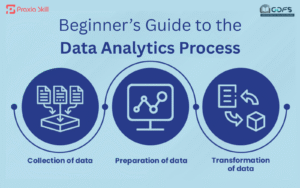Introduction
Data is everywhere. But raw numbers alone don’t always make sense. That’s where data visualisation comes in. It’s the process of turning numbers into charts, graphs, and visuals that are easier to understand.
For beginners, learning how to use data charts and graphs is a powerful skill. It helps you explain trends, patterns, and insights in a way that anyone can follow.
Key Principles of Data Visualisation
Before jumping into chart types, it’s important to know the core principles of good data visualisation:
- Clarity – Keep visuals easy to read and avoid clutter.
- Simplicity – Use only what’s necessary to make the point.
- Accuracy – Make sure the chart reflects the real meaning of the data.
- Consistency – Use similar styles, colours, and scales for related charts.
- Accessibility – Ensure visuals are understandable for everyone, including non-technical viewers.
Following these principles ensures your visuals tell the right story without confusing the audience.
Best Chart Types for Different Data
Not all charts are created equal. Choosing the right one depends on what kind of story you want to tell.
-
Bar Charts
- Best for comparisons between categories.
- Example: Comparing sales across different products.
-
Line Charts
- Perfect for showing trends over time.
- Example: Tracking website traffic month by month.
-
Pie Charts
- Great for showing proportions and percentages.
- Example: Market share of different companies.
-
Scatter Plots
- Useful for showing relationships between two variables.
- Example: Hours studied vs. exam scores.
-
Histograms
- Best for showing data distribution.
- Example: Age distribution of survey participants.
By matching the right chart to the right data, your story becomes clearer and easier to understand.
Beginner Tips for Better Visualisation
- Know your audience – Keep visuals simple for beginners and detailed for experts.
- Use colour wisely – Highlight important points but don’t overuse bright colours.
- Label everything clearly – Axes, legends, and titles should be easy to read.
- Avoid chart junk – Don’t add unnecessary graphics that distract from the data.
- Practice – The more you try different chart types, the better you’ll understand which works best.
Conclusion
Data visualisation is more than just making charts—it’s about telling a story with data. By learning basic principles and knowing which chart to use, beginners can turn raw numbers into clear insights.
Whether you’re comparing categories, tracking trends, or showing proportions, the right visual can make all the difference. Start small, keep it simple, and with practice, you’ll master the art of turning numbers into stories.



